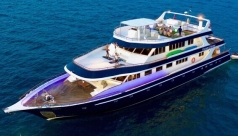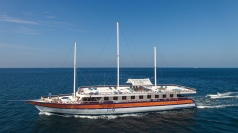The Climate, Diving Season and Best Time to Visit
The Maldives is a year-round destination with water temperatures seldom moving beyond the 26-29°C range, except in the far south where the water temperature can drop to 24°C during the northeast monsoon.
Cruises to the Southern Maldives Atolls typically operate from December to May because the open sea crossings can be unpredictably rough outside of these times.
Northern Maldives Atolls trips usually operate between August and November. This is the time at Hanifaru Bay when hundreds of manta rays and some whale sharks gather on the eastern side of Baa to feast on the vast plankton fields that accumulate there. The area has been declared a marine reserve and current regulations permit snorkelling only for a maximum of 60 persons at a time.
The Far North is dived all year except for June and July, with September to November being generally considered the best time for manta rays.
Ports of Departure and How to Get There
Some Maldives liveaboards that venture a little south or a little north, but also dive some central dive sites, can operate in and out of the port of Male. On such cruises you will be met at Male international airport by liveaboard staff. This is true of Maldives Northern Atolls cruises.
All other tours of the Outer Atolls depart from ports remote from Male and will require an internal or international flight - one way and sometimes return. Domestic flights can be booked with the airlines Maldivian and Flyme. The experience of a seaplane flight over the atolls is unforgettable and should be seen as a bonus rather than an inconvenience. The domestic airports include Gan/Addu (airport code GAN), Hanimaadhoo/Haa Dhaalu (HAQ), Dharavandhoo/Baa (DRV), Fuvahmulah (FVM), Ifuru/Raa (IFU), Kaadedhdhoo/Gaafu Dhaalu (KDM), Kadhdhoo/Laamu (KDO),
Kooddoo/Gaafu Alifu (GKK), Maamigili/Ari (VAM), and Medhufushi (private flights only).
For cruises that use the port of Gan on Addu Atoll, it is also possible to book at international flight to/from Colombo (Sri Lanka) with SriLankan Airlines or to/from Dubai with flydubai. More information on: how to get to the Maldives.
For your protection, we strongly advise securing comprehensive travel insurance that includes coverage for scuba diving and trip cancellation. Our recommended insurance partners offer competitive, dive-specific policies. Get your instant quote here:

Places to Stay
To arrange accommodations before or after your liveaboard safari, we recommend our trusted partner HotelsCombined.com, offering an extensive selection of Maldives hotels and resorts, instant support via 24/7 online chat, secure bookings with credit card, and a 'Best Price Guarantee' for unbeatable value. Explore accommodation options now:

Traveler Tip: For convenient layovers in Malé, day rooms at Hulhule Island (airport) hotels or city properties provide shower facilities, secure luggage storage, and are a comfortable base to refresh before departure.




































